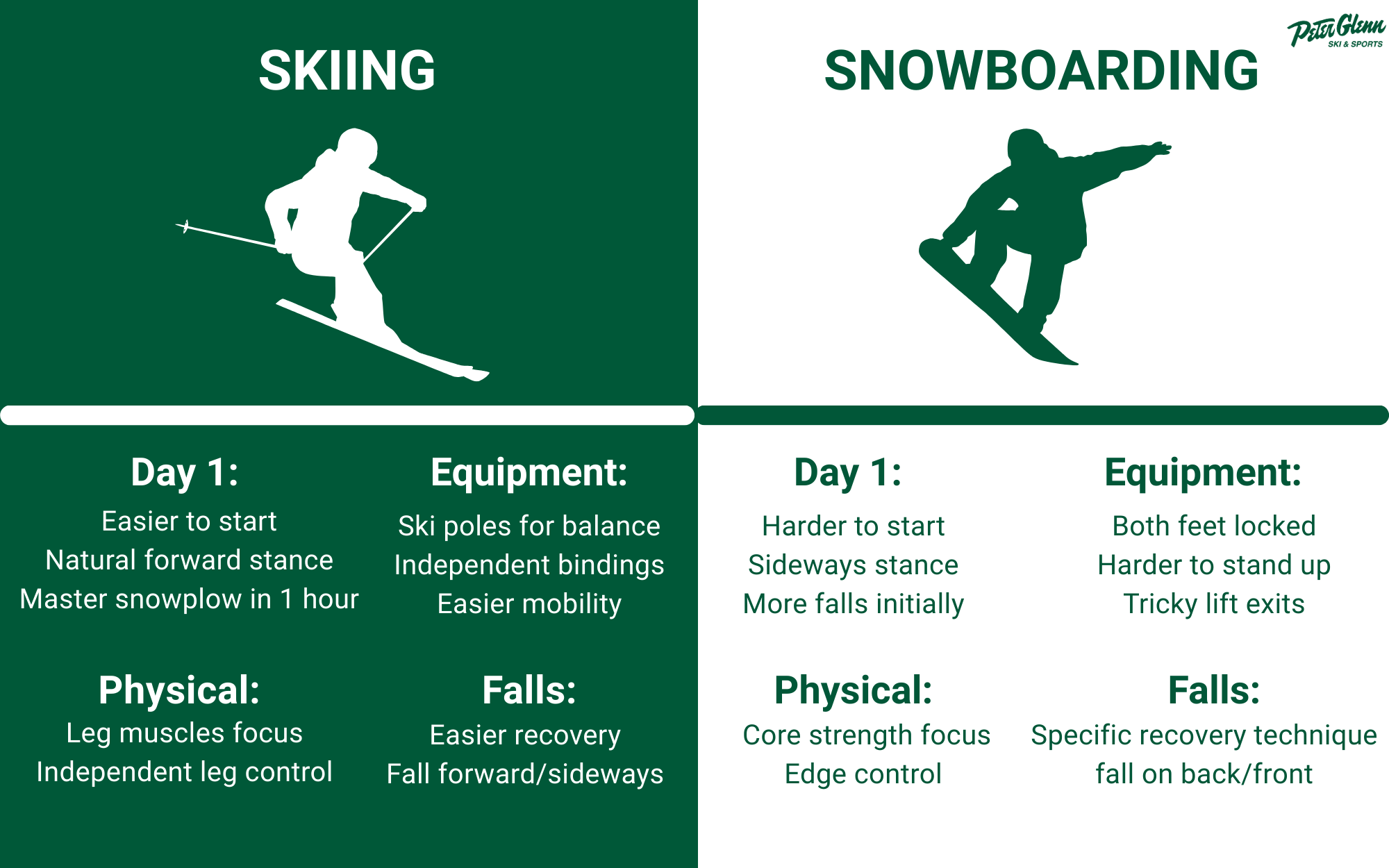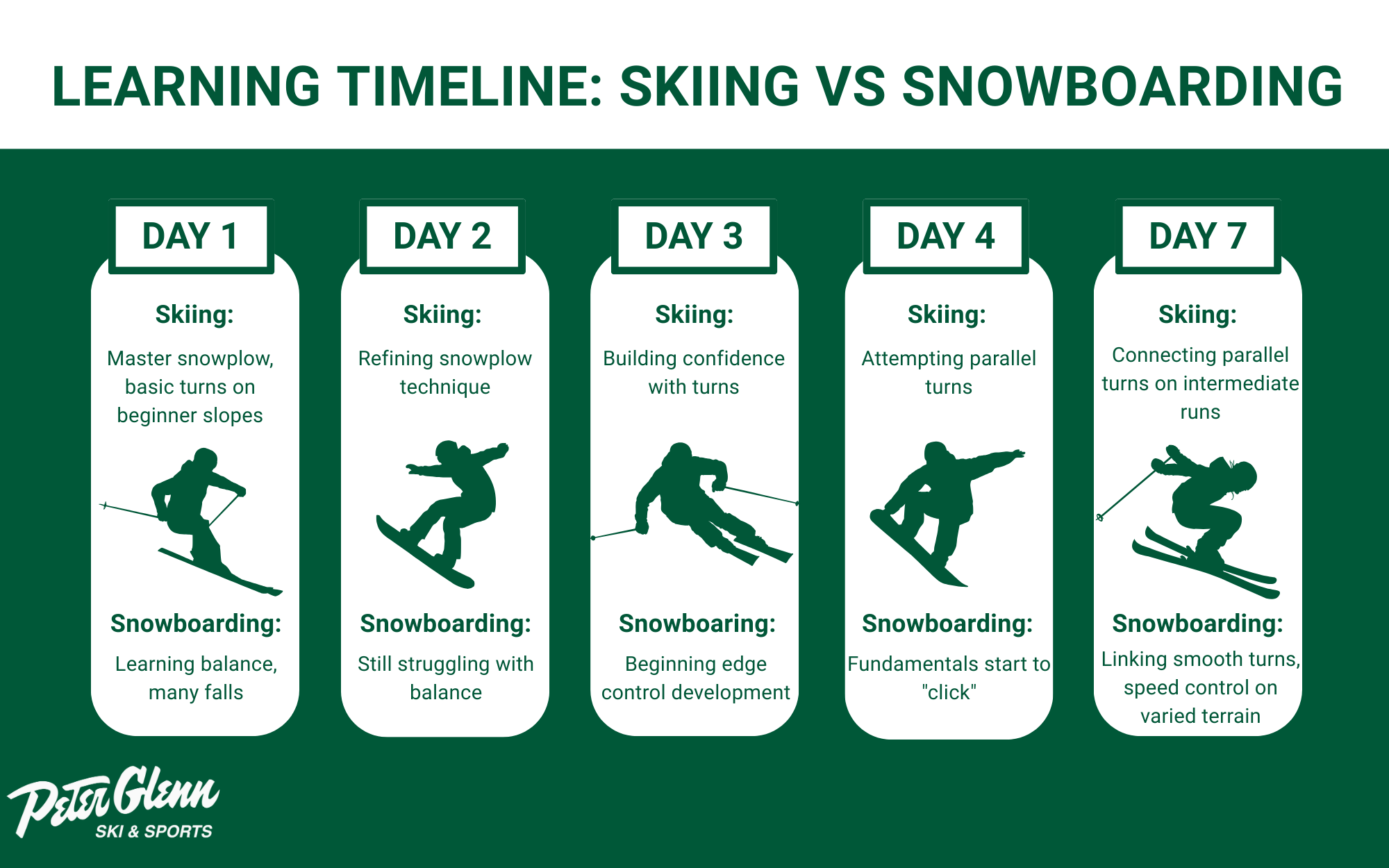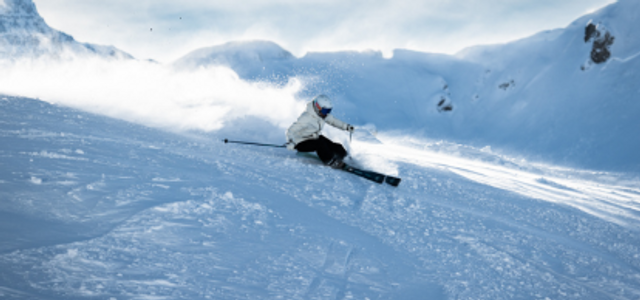Is Skiing or Snowboarding Easier? Complete Beginner Guide
Posted by Peter Glenn Staff on Sep 22nd 2025
Table of Contents:
The Short Answer: Skiing vs snowboarding presents different learning curves. Skiing is typically easier to learn initially due to natural forward-facing stance and independent leg movement, while snowboarding can be harder for a complete beginner but easier to master. Your background in board sports like surfing or skateboarding can influence which snow sport you'll pick up faster.
When deciding between skiing and snowboarding, understanding the unique challenges and learning curve of each sport can help you make the right choice. Skiing offers beginners a more natural starting point – you face forward, your legs move independently, and ski poles provide extra balance support. As a snowboarder, you'll face initial challenges with sideways stance and unified leg movement, but many riders find progression more straightforward once they grasp the basics.
Initial Learning Experience

Natural Movement vs. Sideways Stance
The first day on snow reveals key differences between skiing vs snowboarding basics. Skiing places you in a forward-facing position that matches how we naturally walk and stand. Your legs work independently, which helps most beginner skiers feel stable quickly. Snowboarding introduces a sideways stance that feels foreign to most first time riders, requiring you to stand perpendicular to the direction of travel.
Equipment Setup and Mobility
Ski equipment offers several advantages for complete beginners. Ski poles provide extra balance points and help with movement on flat terrain. The ability to click in and out of bindings independently makes getting up and moving around much simpler. Snowboarders face unique challenges. Both feet are locked to one board, making simple tasks like standing up or moving on flat ground more demanding. Getting off ski lifts also proves trickier for beginner snowboarders compared to skiers.
Basic Movement Learning Curve
Moving on skis often feels intuitive from the start. Beginners can walk, slide, and perform basic snowplow stops within the first hour of practice. The separate leg movement allows for quick adjustments and natural balance corrections. Snowboarders typically spend more time mastering basic movements. The fixed stance requires learning new balance points and movement patterns, particularly the heel edge to toe-edge transitions that form the foundation of snowboard control.
Falls and Recovery
First-time falls differ significantly between the snow sports. Skiers typically fall forward or to the side, with separated legs allowing for easier recovery. When snowboarding, falls tend to impact either the backside or front edge more dramatically, requiring specific techniques to stand back up. However, proper falling technique can be learned quickly, and protective gear helps build confidence during these early learning stages.
Basic Skills Development
Fundamental Techniques
Both skiing and snowboarding begin with a few fundamental techniques that lay the foundation for confidence and control on the slopes.
Skiing:
- Start with the snowplow (or pizza technique)
- Point ski tips together, spread back ends apart to create a triangle shape
- Naturally slows you down and creates speed control
Snowboarding:
- Begin with heel edge control (leaning back to dig heels in)
- Process to toe edge control (leaning forward to dig toes in)
- Focus on balancing while maintaining a stable sideways stance
Balance and Body Position
The way you stand and distribute your weight differs greatly between skiing and snowboarding.
Skiing:
- Forward-facing stance feels more natural
- Independent leg movement allows quick adjustments
- Weight stays centered over both skis
Snowboarding:
- Sideways stance with both feet fixed to one board
- Constant weight shifts between front and back food
- Turns rely on coordinated upper and lower body movement
Speed Control Methods
One of the first skills a beginner must learn is how to control their speed on the slopes.
Skiing:
- Use wide snowplow to slow down
- Progress to parallel turns with skis side by side for smoother, faster control
Snowboarding:
- Control speed while engaging heel or toe edges
- Use upper body to guide balance and transitions
Learning Timeline
The learning timeline for skiing and snowboarding can differ depending on which sport you choose.
Skiing:
- Day 1: Master the snowplow and basic turns on beginner slops
- After ~1 Week: Progress to connecting parallel turns on intermediate runs
Snowboarding:
- Day 1: Focus on learning to maintain balance and develop edge control (expect more falls)
- Within 3-4 Days: Advance to linking smooth turns and controlling speed effectively on varied terrain

Progress to Intermediate Level
Mastering Basic Techniques
Moving from beginner to intermediate level requires different skills for skiing vs snowboarding. Skiers focus on perfecting parallel turns, where both skis move in unison rather than the basic snowplow position. This demands better balance and precise weight shifts between the downhill and uphill edges. Snowboarders work on smooth turn transitions, learning to link heel edge and toe-side turns without catching edges or making abrupt movements.
Technique Refinement Challenges
Skiers often struggle with maintaining proper form while increasing speed. Common hurdles include keeping skis parallel through the entire turn and managing different turn shapes on steeper terrain. Snowboarders face challenges with edge control, particularly mastering the subtle body weight transfers needed for clean turn initiation and completion without skidding or sliding.
Adapting to Different Conditions
Both snow sports require adjusting techniques based on snow conditions. On powder days, skiers learn to distribute weight more evenly, while snowboarders shift weight toward their back foot. Ice and packed snow demand sharper edge control and more precise movements. Moguls present unique challenges. Skiers navigate them through quick, short turns, while snowboarders often traverse them at an angle.
Physical Requirements
The physical demands vary between skiing and snowboarding. Skiing engages leg muscles more independently, requiring strong quadriceps and hamstrings for turn control. Snowboarders rely heavily on core strength and ankle flexibility for edge transitions. Both activities demand good fitness levels, especially at higher altitudes, but snowboarding typically requires more upper body engagement for maintaining balance and initiating turns.
Get Started with Skiing and Snowboarding
Both skiing vs snowboarding offer unique paths to snow sports enjoyment, with distinct learning curves that suit different people. While skiing typically offers an easier first-time experience with its natural standing position and independent leg movement, snowboarding often leads to faster progression once the fundamental balance is mastered. Your personal preference should align with your goals, whether you're planning a single day on the slopes or committing to a season-long adventure.
For complete beginners, renting equipment makes perfect sense to test your preferences without a major investment. When renting, focus on comfort and proper sizing of ski boots or snowboard gear, and don't hesitate to ask for adjustments. The experts at Peter Glenn Ski & Sports can guide you through selecting the right beginner-friendly equipment, from properly fitted boots to boards or skis matched to your skill level.
Ready to start your snow sports journey? Check out our collections of ski and snowboarding equipment to make your first day on the mountain experience memorable.



